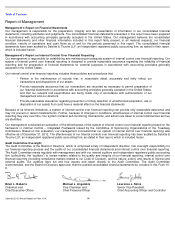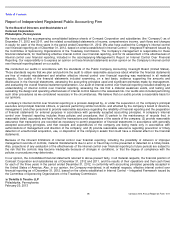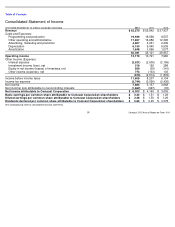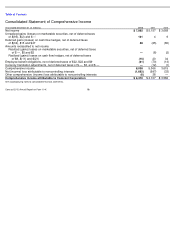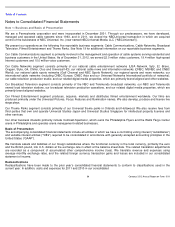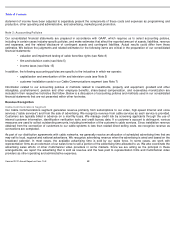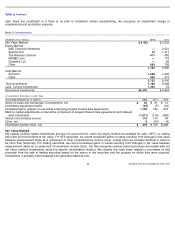Comcast 2012 Annual Report Download - page 86
Download and view the complete annual report
Please find page 86 of the 2012 Comcast annual report below. You can navigate through the pages in the report by either clicking on the pages listed below, or by using the keyword search tool below to find specific information within the annual report.
Table of Contents
Revenue earned from other sources is recognized when services are provided or events occur. Under the terms of our cable
franchise agreements, we are generally required to pay to the franchising authority an amount based on our gross video revenue.
We normally pass these fees through to our cable customers and classify the fees as a component of revenue with the
corresponding costs included in other operating and administrative expenses. We present other taxes imposed on a revenue-
producing transaction as revenue if we are acting as the principal or as a reduction to other operating and administrative expenses if
we are acting as an agent.
Cable Networks and Broadcast Television Segments
Our Cable Networks segment generates revenue primarily from the distribution of our cable network programming to multichannel
video providers, the sale of advertising and the licensing of our owned programming. Our Broadcast Television segment generates
revenue primarily from the sale of advertising and the licensing of our owned programming. We recognize revenue from distributors
as programming is provided, generally under multiyear distribution agreements. From time to time, the distribution agreements expire
while programming continues to be provided to the distributor based on interim arrangements while the parties negotiate new
contract terms. Revenue recognition is generally limited to current payments being made by the distributor, typically under the prior
contract terms, until a new contract is negotiated, sometimes with effective dates that affect prior periods. Differences between actual
amounts determined upon resolution of negotiations and amounts recorded during these interim arrangements are recorded in the
period of resolution.
Advertising revenue for our Cable Networks and Broadcast Television segments is recognized in the period in which commercials
are aired or viewed. In some instances, we guarantee viewer ratings for the commercials. To the extent there is a shortfall in the
ratings that were guaranteed, a portion of the revenue is deferred until the shortfall is settled, primarily by providing additional
advertising time. We record revenue from the licensing of our owned programming when the content is available for use by the
licensee, and when certain other conditions are met. When license fees include advertising time, we recognize the advertising time
component of revenue when the advertisements are aired.
Filmed Entertainment Segment
Our Filmed Entertainment segment generates revenue primarily from the worldwide distribution of our owned and acquired films for
exhibition in movie theaters, the licensing of our owned and acquired films to cable, broadcast and premium networks and digital
distributors, and the sale of our owned and acquired films on both DVD and Blu-ray discs (together, “DVDs”)
and through digital
distributors. We also generate revenue from producing and licensing live stage plays and distributing filmed entertainment produced
by third parties. We recognize revenue from the distribution of films to movie theaters when the films are exhibited. We record
revenue from the licensing of a film when the film is available for use by the licensee, and when certain other conditions are met. We
recognize revenue from DVD sales, net of estimated returns and customer incentives, on the date that DVDs are delivered to and
made available for sale by retailers.
Theme Parks Segment
Our Theme Parks segment generates revenue primarily from theme park attendance and per capita spending at our Universal theme
parks in Orlando and Hollywood, as well as from licensing and other fees. We recognize revenue from advance theme park ticket
sales when the tickets are used. For annual passes, we recognize revenue on a straight-
line basis over the annual period following
the initial redemption date.
Cable Communications Programming Expenses
Cable Communications programming expenses are the fees we pay to license the programming we distribute to our video
customers. Programming is acquired for distribution to our video customers, generally under multiyear distribution agreements, with
rates typically based on the number of customers that receive the
83
Comcast 2012 Annual Report on Form 10-
K



